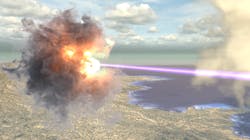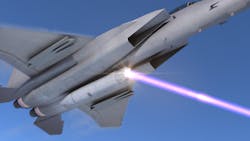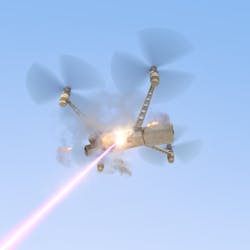Northrop Grumman Space Systems talks high-energy lasers
In this Q&A, Northrop Grumman Space Systems’ Scott Cobb, director of business development for directed energy, Matt Keller, director of directed energy programs, and Brandt Pyles, general manager of directed energy and strategic products, answer our questions about the evolution of high-energy lasers.
The U.S. Department of Defense (DoD) spends roughly $1 billion every year on directed-energy weapons, including high-energy lasers and their directed-energy cousin high-power microwaves. One holdup getting high-energy lasers onto the battlefield is determining how to best use them for missions—but the need for a multilayered defense against drone threats is emerging as an area where they can really shine.
Northrop Grumman is a pioneer of high-energy lasers. The company began working on them during the late 1970s, and the technology has since evolved from being based on chemical lasers to electric lasers, and now fiber lasers. Among their key innovations: laser power scaling; beam combination; advanced targeting and tracking; modularized architectures; scalable subsystems; low size, weight, power, and cost; rugged components and materials; and miniaturized systems with high-power output.
Laser Focus World: How do you define high-energy lasers?
Matt Keller: High-energy laser systems use directed energy to detect, track, and defeat threats at the speed of light. They’re generally kilowatt-class or greater continuous-wave lasers that can defeat unmanned aerial systems (UAS), rockets, artillery, mortars, small craft, and cruise and hypersonic missiles, as well as other threats.
LFW: Main benefits of high-energy lasers?
Matt Keller: We’re using the fastest thing available: the speed of light. We can send light to a spot and focus on it to defeat threats. As long as you have a power source, you can keep on firing—you never run out of ammunition.
In terms of distance and accuracy, lasers have a significant advantage over kinetic weapons. It’s nice to generate photons, but what good are they unless you can get them to a target? So the U.S. military can use our high-energy laser systems to optically track threats before defeating them with the laser. It’s a very accurate way of both tracking and defeating a threat.
Brandt Pyles: Another cool thing about lasers is seeing the physical impact light can have on what we think of as ‘hard’ targets. A 100 kW laser, for instance, can punch a hole in a 2 in. plate of steel in seconds from several kilometers away. It’s quiet and invisible, and its impact is instantaneous.
High-energy lasers are also tunable. Operators can put out just a little bit of power, 50% of power, or go full power. You can’t do this with a kinetic weapon, like a gun or a bullet: You either pull the trigger and shoot or you don’t. And if you do, you’ve fired that projectile for as far as it will go. With a laser, you’ve got more options. You can dazzle or damage a sensor without destroying the whole target.
LFW: What are the main applications for high-energy lasers?
Scott Cobb: Northrop Grumman’s laser systems are designed to be versatile and can be used for both surveillance and reconnaissance, as well as to defeat threats—all wrapped up into one payload. They can be deployed in any warfighting domain: On land, at sea, and in the air. Our technology protects U.S. forces from a range of threats, such as UAS, rockets, artillery, mortars, fast-attack boats, and missiles.
LFW: How do high-energy lasers compare to their directed-energy cousin high-power microwaves?
Scott Cobb: The most effective and efficient means to counter drone swarms is through a layered, in-depth, and complementary approach that uses high-energy lasers and high-powered microwaves.
High-energy lasers offer a more focused beam that can deliver a lot of energy over a long distance, while high-power microwaves offer a much broader beam that can be used over a shorter distance.
High-energy lasers offer precision targeting and faster engagement times, and they can engage hovering or maneuvering targets at significant distances. They also can be used to temporarily disable a UAS, if the situation warrants it.
LFW: How quickly is the technology evolving?
Brandt Pyles: We see iterative, incremental improvements in laser sources that depend on laser diodes, such as fiber amplifiers. These improvements rapidly yield greater output power per unit volume, mass, and better quality in the output beam. These improvements increase the industry’s ability to perform missions efficiently.
In the 20th century, the realistic applicability of high-energy lasers was reserved for giant laboratory demonstrators the size of a whole building. By the turn of the century, they evolved into bulky one-offs. Laser weapon systems are now good enough and practical enough to provide mission utility in real-world environments. We’re starting to see them as smaller, integrated systems on our nation’s warfighting platforms, including the U.S. Navy’s Laser Weapon System Demonstrator and the U.S. Army’s Directed-Energy Maneuver Short-Range Air Defense System.
As high-power lasers are more frequently deployed, the pace of their improvements and the speed and momentum of the industry flywheel will increase significantly as well. High-energy lasers are like computers in this way. Decades ago, computers took up entire buildings, and look at them now: smaller, more powerful, and more affordable.
Matt Keller: Northrop Grumman’s lasers are constantly evolving. We’re constantly asking: What’s next? How can we do the mission more effectively, scale to higher efficiency, power, reliability, and miniaturize not only the laser and beam control, but the power source and the required cooling? We’re continuing to deploy and refine our capabilities with these advancements for our customers. Because we understand their missions, we can combine a variety of different core technologies and capabilities. And we’re presently developing a high-energy laser system that can be scaled to more than a megawatt. Our technical approach will provide a precise, low-cost, speed-of-light solution for military operations.
LFW: Can you give us an overview of Laser Weapon System Demonstrator (LWSD) and how it’s performing for the Navy?
Matt Keller: Our LWSD, the largest laser ever deployed on a Navy ship, recently wrapped up a successful mission on USS Portland. The 150 kW-class laser tracks targets and uses directed energy to stop and destroy hostile drones, small craft, and other threats.
The U.S. Navy began testing the LWSD aboard the USS Portland in 2019, demonstrating its ability to track and destroy multiple unmanned targets. It was operated and maintained by sailors.
As a contractor, we learned a lot during the LWSD’s deployment on the USS Portland, including which features operators want to see on an operating console and how best to package maintenance responsibilities for sailors sustaining the system on the ship.
LFW: Why is now, finally, the time for the Pentagon to give a full green light to high-energy lasers?
Matt Keller: Directed energy is a critical capability that must be further developed to keep the nation ahead of emerging threats. High-energy lasers offer an affordable solution to these growing threats.
About the Author
Sally Cole Johnson
Editor in Chief
Sally Cole Johnson, Laser Focus World’s editor in chief, is a science and technology journalist who specializes in physics and semiconductors.



